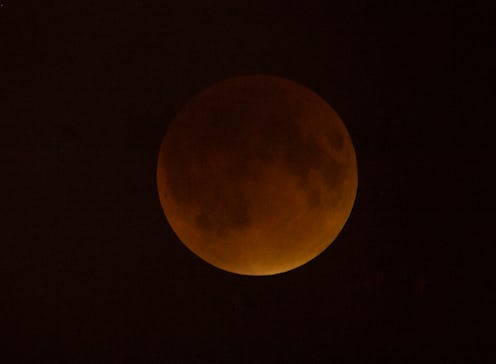Life
This Month’s Total Lunar Eclipse Will Be The Longest One To Take Place This Century

The month of the July is filled with some pretty exciting astrological activity. First Mars went retrograde at the end of June, a period which lasts through July and into August. Then there was the July new moon that happened to fall on Friday the 13th (spooky!). Now we're looking forward to July's full moon (called the Buck Moon), which is happening on Jul. 27, and also happens to be a total lunar eclipse (aka a Blood Moon), as well as a micro full moon. Oh, and on top of that, Mercury goes retrograde on Jul. 25. Whew! This definitely isn't something that happens all the time, especially the eclipse part. To put it in perspective, you have to think about how the July Buck Moon is also a total lunar eclipse, as well as how often total lunar eclipses happen.
When it comes to the total lunar eclipse side of things, this is a fairly rare occurrence, although not quite as rare as you might think. According to MoonBlink, total lunar eclipses happen once in a year about every three and a half years, and three in a year about every 200 years. A lunar eclipse only happens during the full moon, and a total lunar eclipse can only happen when the sun, Earth, and moon are perfectly lined up. Anything less than perfect means it's just a partial eclipse. A total lunar eclipse develops over time. During a total lunar eclipse, the Earth's shadow has fallen on the moon. Space.com explained, "The moon won't completely disappear, but it will be cast in an eerie darkness that makes it easy to miss if you were not looking for the eclipse."
A total lunar eclipse is also known as a Blood Moon. Due to Earth's shadow on the moon, the moon will appear red or red-brown instead of its usual white. The next total lunar eclipse will happen on January 19, 2019 and will be visible from North and South America, Europe, and Africa.
The total lunar eclipse in July 2018 is extra special because it's the longest total lunar eclipse of this century. The total phase of the eclipse will last one hour and 43 minutes, and from start to finish, the entire event will last nearly four hours. It will be visible to people in Africa, the Middle East, southern Asia, and the Indian Ocean region (as long as the skies are clear, of course).
This particular moon is also known as the Buck Moon, a name given by the Algonquin tribes. In ancient times, Native Americans used the moon cycle to keep track of the seasons, since they didn't have calendars yet. They picked the names based on events and things that occurred during that time. The July full moon is called the Buck Moon because it's at this time of the month that male deer start to grow back their antlers. Bucks shed their antlers each year, and in July, their antlers grow back. Deer were extremely important to the Algonquin tribes, as they were used as food and clothing, so it makes sense that they chose this name. The July full moon is always referred to as a Buck Moon.
Lastly, this month's full moon is also a micro full moon. The point in the Moon's orbit farthest from Earth is called "apogee." When a full moon occurs around apogee, it's called a micro full moon. Those who keep track of the moon on a regular basis will notice that it appears to be slightly smaller than usual. The next micro full moon will happen on September 14, 2019. It happens about once a year, so it isn't super rare.
So, how often is the July Buck Moon also a total lunar eclipse? Well, the last total lunar eclipse was January 31, 2018, and the next one is January 21, 2019. According to a chart that maps out future eclipses - total, partial, and prenumbral - there is no total lunar eclipse happening in July until at least after the year 2030. It's safe to say that you won't see a total lunar eclipse fall during a Buck Moon in a very long time, so if you want to catch a glimpse, you better book a vacation!